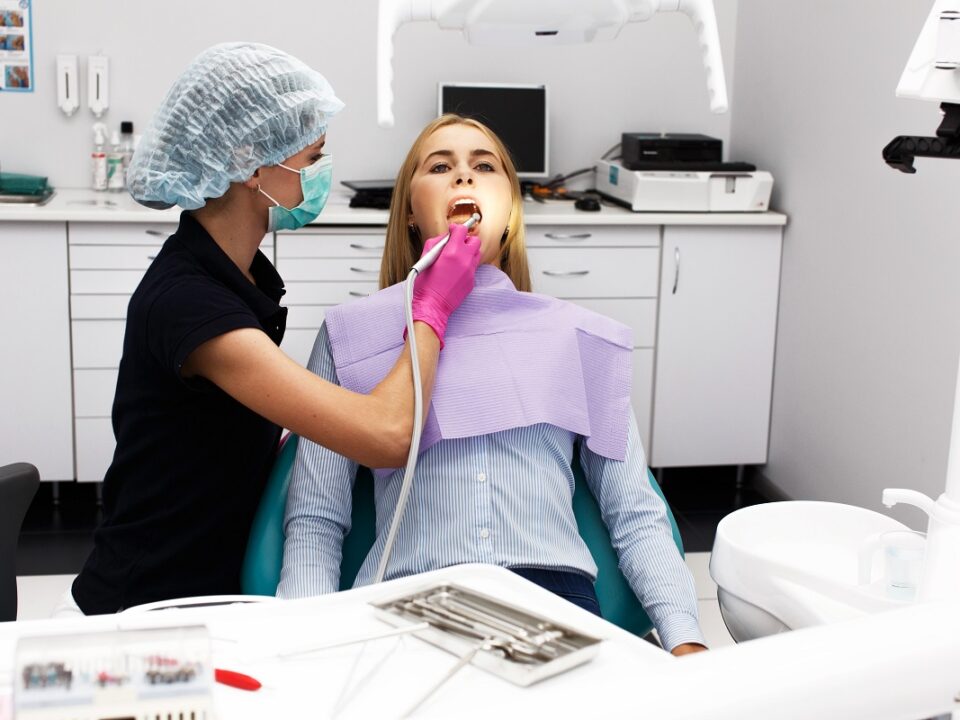
Mouth-Body Connection
September 23, 2022
Dental anxiety – dental phobia
October 28, 2022Deep teeth cleaning at the Dentist
Getting and maintaining a healthy smile involves more than keeping your teeth white and free from decay. You also need to take care of the structures within your mouth that support your teeth, such as your gums.
Deep teeth cleanings are meant to treat periodontal or gum disease; a deep teeth cleaning is often advised for people who haven’t had regular dental cleaning appointments for a while but it’s most likely to be recommended for anyone who has gum disease or periodontal issues.
What is deep teeth cleaning?
Deep teeth cleaning, usually referred to by dental professionals as gum scaling and root planing, is a dental treatment designed to clean between the teeth and gums all the way down to the roots.
During a standard dental cleaning, a dental hygienist or dentist cleans the front, back, and sides of the tooth above the gum line.
This same process is performed during a deep teeth cleaning, but the dentist also continues down to the root of the tooth, removing all the plaque and tartar from below the gumline.
Scaling and root planing are common steps in periodontal therapy in patients who have a variety of symptoms, such as:
- Red, inflamed, or bleeding gums
- Bleeding gums when brushing or flossing
- Chronic bad breath
- Pain when chewing
- Receding gum line
- Pockets near the roots of the teeth
- Tartar build up near the roots
Why do dentists have to do deep teeth cleaning?
You may need deep cleaning, as opposed to regular cleaning because it is an advanced process that clears out the bacteria from the roots. If your gums are diseased or your gingivitis has gotten to the point where they are pulling away from the teeth and creating pockets, a deep cleaning procedure is what is best recommended.
How long does a deep teeth cleaning take?
A deep teeth cleaning takes longer than a dental cleaning and it may take as long as 1.5-2 hours total for the entire procedure. The reason why deep cleaning takes longer is because your dentist has to take an extra step to remove tartar form under your gumline.
Deep teeth cleaning is usually split up into two appointments so each session would be about 45-60 minutes in length total.
In your first appointment we will perform the scaling part of the process, that removes all the plaque and tartar from below the gumline. On your second appointment, we do the Root planing, or the second part of the deep teeth cleaning procedure, it requires that we a scaling instrument to clean plaque, tartar, and other build-up from the roots of your teeth.
How do they do a deep cleaning on your teeth?
When scaling during a deep cleaning, we will first administer a local anesthetic to control discomfort. Then we will reach deeply down into bottom of the gum pockets to chip away tartar with a scaling tool and remove any plaque that’s collected in the pockets, too.
Once tartar has been removed form your teeth, we will use a tool called to reshape your tooth roots. Planing smooths the roots to create a more adhesive surface. As your gums begin to heal, they reattach to your teeth to keep your teeth secure and to form a barrier against bacteria.
After your final treatment, we will ask you to return to Digital Dental Studio so that we can examine your teeth, gum, and bones, measure your gum pockets, and determine if your disease is under control. If your disease was at an early stage, you may need only one deep-cleaning series to reverse the periodontitis. If your periodontitis is more advanced, and you still have evidence of gum pockets or bone loss, you may need to have deep cleanings on a regular basis to keep your teeth and gums healthy.
Does deep teeth cleaning hurt?
Before a dental deep cleaning procedure, the gums may be swollen or inflamed. So to minimize discomfort and pain, we will administer a local anesthetic to numb your gums.
You should be aware that discomfort can happen after the treatment, your gums may be sensitive for the next couple of days. There are options available to reduce any form of soreness or sensitivity like over-the-counter painkillers. Rinsing the mouth with salt water can help alleviate the swelling and discomfort too. Remember to avoid eating or drinking anything at high temperatures and crunchy foods.
Although your gums might be a bit sore, it’s important to maintain your oral hygiene at home to prevent the infection from reoccurring. We’ll explain how to brush and floss your teeth to allow your smile to heal.
How much does teeth deep cleaning cost
The answer to “How much is a deep dental cleaning?” varies significantly based the severity of the case.
How often do you need a deep cleaning
Deep teeth cleaning is an effective way to reverse the first stage of gum disease and manage it. Since every patient is different, during your routine checkups we will recommend whether or not you should get a deep cleaning or how many you may need.
One clear sign of needing deep cleaning is checking for gum disease. We can do this by measuring how far your gums pull away from your teeth. If there are 5 millimeters of depth in your gums, will require this treatment. It’s also recommended to get a deep cleaning if it’s been more than six months since your appointment with your dental hygienist.
What and when can I eat after deep teeth cleaning.
After deep cleaning treatment, it is important to follow instructions provided by the dentist or periodontist on what and when you are able to eat.
Here are some examples:
- Let the anesthetic wear off completely. Wait until the mouth is no longer numb before eating anything or brushing.
- Stick to soft foods, like pasta or mashed potatoes. Your mouth will likely be too sore to bite into an apple or chew a piece of steak. Still, even once you feel better, be careful about attempting anything crunchy or chewy or that could be stuck under gums like popcorn. This could damage the gums before they have a chance to heal.
- Avoid hot liquids. Hot beverages can increase bleeding in the first few days.
- Do not smoke
- Alcoholic beverages will slow the healing process.
What not to eat after deep teeth cleaning
After your deep cleaning, recommend avoiding the following foods:
- Extremely hot or cold food for the next 24-48 hours.
- Avoid acidic foods (your teeth will be sensitive)
- Hard, crunchy, sticky, or chewy foods until your gums have fully healed. Such as popcorn, chips, or seeds for several days. Sharp particles of these foods can become lodged in the spaces between the teeth and gums, further irritating the tissues and causing setbacks.
What to expect after deep cleaning.
After a deep cleaning, you may have pain for a day or two and teeth sensitivity for up to a week. Your gums also may be swollen, feel tender and bleed.
To control pain, you may consider over-the-counter pain medication, mouth rinse or salt water to hasten the healing process. Depending on the severity of the case, we may also insert medication (subantimicrobial-dose doxycycline) directly into the pocket that was cleaned.
It’s important to schedule regular visits to the dentist, first to check that your gums properly, and second to verify if more treatment may be needed.
Deep cleaning treatments can reverse the first stage of gum disease (gingivitis) and help prevent periodontitis from becoming unmanageable.
Can you brush your teeth after deep cleaning
It’s not only recommended it is a must. It might be difficult for you to brush your teeth for a few days after deep cleaning, but you should make sure that you continue with your regular oral hygiene routine, brushing at least twice a day and flossing once a day. Use a toothbrush with soft bristles and use very gentle forces to clean your teeth.
Difference teeth cleaning – deep cleaning
The difference between a deep dental cleaning, which includes scaling and root planing, and routine dental cleaning is really just a matter of thoroughness. Dental hygienist who will remove plaque from your mouth on your next visit is doing a general cleaning so the dentist can see what may need treatment. Deep cleaning is a more complex procedure, includes root planing, and may include another treatment like using lasers to kill bacteria.
Gum health requires the removal of tartar from the entire tooth, both above and below the gum line. This might be done with an ultrasonic tool, an old-fashioned metal pick, or another tool.
Root planing is another aspect of gum therapy that smooths out the surface of the tooth below the gum line. A rough surface provides pockets where bacteria can grow. Smoothing the surface prevents pockets from developing.
Disadvantages of deep cleaning teeth
Deep cleaning teeth is generally considered the optimal treatment for periodontal disease. Like any dental procedure, you may experience some pain, swelling and soreness afterwards.
Here are some of the side effects you might experience:
- Can cause discomfort: May cause pain and/or bleeding.
- May not fully address infection: Scaling and root planing address the causes of infection, but may not wholly resolve it.
- Can cause increased sensitivity: Sometimes causes sensitivity, particularly to heat and cold.
It is safe to say that side effects of professional and deep teeth cleanings are minor and temporary, so they will only last for a maximum of 5-7 days.
Alternatives to deep teeth cleaning
Root scaling and planing is the usual first step to treat gum disease. It involves pulling back the gums from the tooth roots, cutting away infected gum tissue, and scraping tooth root surfaces to remove bumps and formations where bacteria could colonize.
Laser deep cleaning, is a gentler, more comfortable way to clean the tartar and plaque from below the gumline without the use of dental tools to pull the gums away from the teeth. The laser penetrates the soft tissue, and the heat breaks down the plaque and bacteria. Laser deep cleaning is much more efficient and comfortable than conventional scaling and root planing.
What can Dr. Anna Vishart do for you
At Digital Dental Studio, we are proud to offer the latest technology available for periodontal therapy: laser treatment. There are numerous advantages to using laser therapy as opposed to the traditional methods.
Dr. Vishart and her team perform a variety of procedures using laser technology, as a way to regenerate healthy gums and remove diseases areas in a virtually painless way. This method also encourages healthy gum to regenerate and attach to the teeth. There is a much lower chance of gum disease returning when laser therapy is used as opposed to traditional deep cleanings.
Don’t Wait To Restore Your Healthy Smile! Anna Vishart and her wonderful team are here to solve any concerns you may have about deep cleaning treatments. Contact us today 1-781-471-7934.




